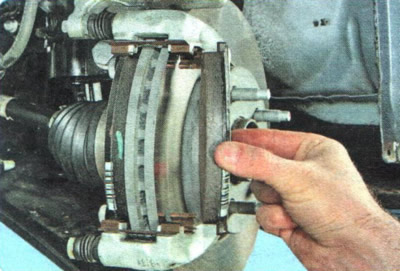Check the condition of the brake pads at every service.
Brake pads need to be replaced when the pads are worn (minimum allowable thickness of friction linings 2 mm), loose connection of linings with the base, oiling of working surfaces, the presence of deep grooves or chips.
WARNINGS: Replace front brake pads only as a set of four (two on each side). Before replacing the brake pads, check the brake fluid level in the master cylinder reservoir. If the level is close to the mark «MAX», it is necessary to pump out part of the liquid (for example, a medical syringe or a rubber bulb), because after replacing worn pads with new ones, the level will rise.
1. Loosen the nuts of the left front wheel, place wheel chocks under the rear wheels («shoes»), Jack up the front of the vehicle, support it securely, and remove the left front wheel.

2. Loosen the bolt securing the lower guide pin of the caliper, holding the finger from turning with the second key...

3.... and remove the bolt.

4. Remove the brake hose retainer from the bracket slot on the shock strut.

5. Raise the caliper up...

6.... remove the outer...

7....and internal brake pads.

NOTE: This is what the front brake pads look like. They differ in shape and design (an audible wear limit indicator is installed on the inner pad, shown by an arrow in the photo), as well as part numbers.

8. Remove the bottom...

9.... and the upper clamping springs of the pads and inspect them.

NOTE: Replace deformed or badly corroded springs.

10. Drown the piston of the working cylinder with the help of sliding pliers.
USEFUL ADVICE: Every time you replace the brake pads, be sure to check the condition of the protective rubber boots of the guide pin and the movement of the caliper relative to the brake pad guide. If movement is difficult, lubricate the caliper guide pins with grease.

To do this, remove the guide pin...

...lubricate it with grease and then grease the pin guard. Lubricate the second guide pin and its boot in the same way.
Install the guide pins in the reverse order of removal.

Replace the guide pin guards if they are hardened, deformed, or torn.
11. Similarly, replace the brake pads of the brake mechanism of the right front wheel.
12. Check up and if necessary restore level of a brake liquid in a tank of the main brake cylinder.
USEFUL ADVICE: After replacing worn-out brake pads with new ones, do not rush to immediately go to busy highways. It is possible that at the very first intensive braking you will be unpleasantly surprised by the low efficiency of the brakes, although the pads are branded. Brake discs also wear out, and new pads only touch them at the edges, with little to no braking. Choose a quiet street or passage without cars and slow down gently several times so that the pads get used and begin to fit the entire surface. At the same time, evaluate the effectiveness of the brakes.
Try not to brake sharply for at least the first 100 km. With strong heating of unused pads, the top layer of their linings burns and the brakes will not be as effective as possible for a long time.
